Abstract
Advancing smart production systems for green production remains a crucial priority for manufacturers, while the vision to achieve green supply chain management process (GSCMP) remains obstructed due to using less fuel-efficient technologies. This study suggested an intelligent logistics design that infused technological indicators with logistics performance indices (LPIs) to minimize carbon damages in a panel of 102 countries. The study used patent applications and trademark applications to analyze the technological progress, whereas LPIs—i.e., LPI-1 for assessing quality and competence services, and LPI-2 for trade and transport infrastructure—are used to determine supply chain management process across countries. The results show that carbon damages follow a U-shaped structure with technology-induced LPIs (TI-LPIs) and GDP per capita. The country’s GDP per capita and TI-LPIs decrease carbon damages up to US$15,000,000, while the moderation of patents application (and trademark applications) with LPI1 and LPI2 substantially decreases carbon damages up to US$13,800,000 (US$34,100,000) and US$6,100,000 (US$20,200,000), respectively. The causality estimates confirmed the growth-led carbon damages, technology-led carbon damages, growth-led logistics indices, and technology-led growth across countries. The results emphasized the need to move forward by adopting fuel-efficient technologies to minimize carbon damages across countries.
1. Introduction
The United Nations proposed 17 developmental goals to the world community in 2015, among which climate change and smart technologies are mostly emphasized to minimize carbon damages and ensure sound and healthy economic recovery through which a country can reduce poverty and hunger issues [1]. The green supply chain management practices can mitigate climate issues through technological up-gradation in logistics activities and ensure low carbon base activities through which global average temperature could be reduced up to 1.5 °C, as suggested in COP25 in Madrid, 2019 [2,3,4,5]. According to the latest report of World Bank [6] that discussed the world ranking of overall logistics performance, Germany is placed in first position for logistics performance index (LPI) score, i.e., 4.19 out of 5, Netherlands in the second position, i.e., 4.07, Sweden, Belgium, Singapore, United Kingdom, Japan, Austria, Hong Kong China, and United States are placed in the following positions with an LPI range of 3.92 to 4.07. The LPIs consist of six critical dimensions: customs clearance process, quality of trade infrastructure, competitive price shipments, logistics competence and quality services, tracking and tracing consignments, and expected timeliness of delivery products. Figure 1 shows the top 10 logistics countries’ profiles of their six key dimensions.
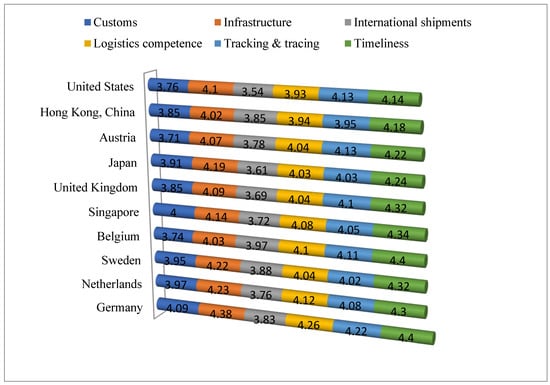
Figure 1.
Top 10 Countries’ Logistics Updates in 2018. Source: World Bank [6].
Technology-embodied economic growth is visible mainly in different industrial settings. The earlier literature favors technical up-gradation that supports countries’ economic growth [7,8,9,10,11], while during large scale economies of production, the byproduct of carbon emissions is primarily discharged that sabotaged the United Nations sustainable development agenda [12,13,14,15]. Industrial sustainability could be achieved through sound environmental regulations and technology embodied the supply chain to provide a pathway to make sustainable development [16,17]. The smart technologies and production system could reduce the global environment; however, it is highly optimistic about improving logistics activities to become fuel-efficient, which largely supported corporate environmental and social responsibility [18,19,20]. Zaman and Shamsuddin [21] considered a panel of 27 EU countries by using a time series data of 2007–2014 and found that LPIs have a healthy and positive relationship with energy efficiency that turned into increase countries economic growth. The critical dimensions of LPIs have a varied impact on the country’s resource agenda. In general, the results show that due to high dependency on fossil fuel combustion, LPIs mainly deteriorate the natural environment in the form of high mass carbon emissions, which further interlink them with industrialization and financial liberalization policies, which negatively affect green supply chain management agenda across countries. Khan and Qianli [22] surveyed data of the United Kingdom from 1981 to 2016 to analyze the possible relationships among growth-related factors, LPIs, and environmental pollutants. The results show that renewable energy demand, FDI inflows, and economic growth are potential green supply chain management factors in a country. The policy mix related to the utilization of energy resources in the national portfolio is highly desirable to catch up on the green effects of LPIs in a country. Zaman [23] analyzed the role of renewable energy sources on the environmental cost of doing business in the context of BRICS countries using data from the period of 1995–2015. The results show that hydropower energy supported green supply chain management practices under the premises of economic growth and FDI inflows across countries. The study concludes that BRICS countries should require green energy policies to achieve energy efficiency that would play a vital role in attracting more foreign investors to produce environmental goods. Yu et al. [24] invested the relationship between LPIs, energy demand, economic growth, and ecological indicators in a panel of 19 developed countries for a period 2008–2017. The results show that LPIs increase with energy demand, FDI inflows, and trade openness while they decrease along with an increase in carbon-GHG emissions across countries. The need for green logistics policies is highly desirable for generating corporate green payoffs. Aldakhil et al. [25] considered BRICS countries as a case study to propose an integrated supply chain management model, which is aggregated by various measures of LPIs, growth factors, and environmental resource indicators. Although in favor of logistics, the results drive economic growth; however, it further escalates carbon emissions, which is a severe concern for developing corporate environmental sustainable policies to mitigate environmental pollution through cleaner production technologies. Liu et al. [26] covered a larger panel of Asian countries for analyzing the possible linkages between ecological degradation and LPI by using data from the period of 2007–2016. The results show that some LPIs, industrialization, and urbanization escalate carbon emissions, while trade openness improves the natural environment through importing green products across countries. The study emphasized the need to improve the timeliness of logistics activities responsible primarily for increasing carbon emissions in the current scenario. Khan et al. [27] examined the potential determinants of green supply chain management across SAARC countries by utilizing a data period from 2001–2016. The results show that LPIs used a combination of fossil fuel combustions and non-renewable fuels that exert a negative impact on the country’s economic growth and environment. Further, due to a lower quality of trade infrastructure, LPI increases carbon and fossil fuel combustion. In terms of the efficient customs clearance process, green supply chain management’s vision is achieved mainly in the selected Asian countries. Table 1 shows the recent strikes of literature on technological innovation and environmental degradation across countries.

Table 1.
Current Literature Review on Technology-Induced LPIs and Environmental Sustainability Agenda.
Contribution of the Study, Research Questions and Objectives of the Study
The study has a novel contribution in the present scholarly work from three different perspectives; firstly, the study used technology-induced logistics performance indices in carbon modeling, which is relatively less likely to be used in the existing studies [39,40]. Secondly, the study used the moderation effect of technological indicators, including patent application and trademark applications with logistics performance indices related to quality services and trade infrastructure to assess the non-linear relationship with carbon damages across countries. The previous studies are less likely to determine the moderation effect with the stated combination in carbon modeling in a diversified panel of countries. Finally, the study used few control variables, including GDP per capita, insurance and financial services, industry value-added, and medium & high tech industry in carbon modeling that is important to assess inverted U-shaped Environmental Kuznets Curve (EKC) hypothesis, industry associated emissions, green financing and insurance coverage, and high-tech pollution intensity level across countries. The earlier studies limited to cover these factors in different economic settings [41,42,43,44,45].
Based on the soundness of the study, the study proposed a set of research questions to assess the potential causal factors of carbon damages that increase the cost of carbon abatement across the globe, firstly, do supply chain management practices inflame sustainable enterprise policies that negatively lead to the country’s green developmental projects? This question is essential in the two main perspectives; first, the manufacturing firms are mainly involved in delivering consignments to the outreach clients, using fossil fuel energy, vehicles, and managing trade infrastructure; thus, firms need strong logistics support to complete the stated tasks. Logistics activities require more power to gear their running operations; therefore, their activities cause severe environmental pollution that raises environmental degradation challenges across countries. Secondly, the negative environmental externalities of logistics activities deteriorate the national agenda of green development, which suffers due to increased healthcare expenditures because of rising pollution. In monetary aspects, manufacturing firms enjoy surplus profit at the cost of the country’s vision of green and healthy development, which increases economic and financial distress across countries. The second research question is related to technological advancement in improving logistics performance that helps to minimize economic and financial sufferings. We investigate the reason behind high mass carbon emissions that lead to unsustainable supply chain management practices, i.e., could advancement in technology-induced logistics performance improve supply chain management practices to enhance the quality of air indicators? The question raised a severe reservation about the role of technology in advancement in green supply chain management practices on a global scale. Finally, the third question is directly linked to the country’s economic growth, which assumes that country’s growth-specific factors would mainly support technological advancement in a way to improve logistics performance indicators to limit carbon emissions. The question arises whether continued economic growth, industry value-added, medium and high –tech industry, and insurance and financial services would support technology innovation to infuse logistics activities to reduce carbon abatement cost? These three questions are mainly crucial in devising corporate-level policies and economic policies to better the country’s vision to achieve green development.
Based on given research questions, the study made the following research objectives:
- (i)
- To examine the role of logistics performance indices in the cost of carbon emissions across countries.
- (ii)
- To investigate the dynamic linkages between technological factors and carbon damages in a panel of selected countries.
- (iii)
- To determine the potential impact of economic growth, industry value-added, medium and high-tech industry, and insurance and financial services on the cost of carbon emissions across countries, and
- (iv)
- To substantiate an inverted U-shaped relationship between carbon damages and economic growth, and carbon damages and technology-induced logistics performance indices across countries.
Using the dynamic panel econometric techniques, these objectives could be achieved to get robust inferences, including GMM estimator, VAR Granger causality, and innovation accounting matrix. The given estimators would give sound reasoning about the given phenomenon’s real situation and provide a list of policy implications to move forward for green supply chain practices at a global scale.
2. Materials and Methods
The data of the candidate variables reported in Table 2 is accessed through the World Bank [46] database, covering 102 countries from 2010 through 2018. The list of sample countries is shown in Table A1 in the Appendix A . The data of logistics performance indices is missing mainly during the period filled by preceding and succeeding values of the respective variables, where required. The same technique is used for other variables lost in some data points over time.

Table 2.
List of Variables. Source: World Bank [46].
The study is evaluated three different alternative and plausible hypotheses:
- (i)
- Environmental Kuznets Curve (EKC): The EKC shows the non-linear relationship between income per capita and per capita carbon emissions at the second-degree quadratic version. The nominal GDP per capita and its second degree confined its positive and negative impact on carbon emissions, respectively, to substantiate an inverted U-shaped EKC hypothesis [47,48,49]. The other forms could also be found under different socio-economic and environmental factors across varied economic settings [50,51]. Figure 2 shows the five different possibilities of EKC hypotheses to clearly understand the given concept to use in a given study for more critical insights. Line A shows an inverted U-shaped relationship between the country’s income and carbon emissions, which first increases than decreases carbon emissions due to vital environmental reforms being done through the country’s economic growth. Line B shows the U-shaped relationship between the two stated factors that show carbon emissions decrease initially with the country’s economic growth that later increases due to high industrialization caused by continued economic growth. Line C shows the flat EKC hypothesis, which argued that both the variables have no relationship. Line D shows monotonic decreasing function, while line E shows the monotonic increasing function that shows only one portion of the EKC hypothesis, either from the right side or left side, while the latter is insignificant.
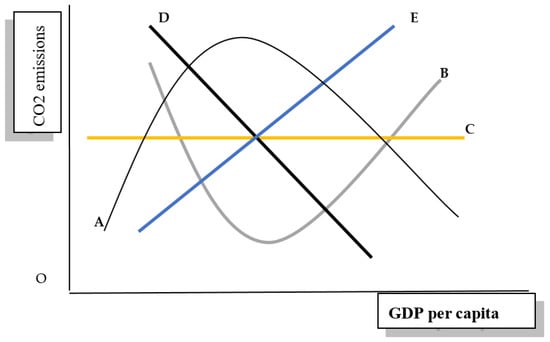 Figure 2. Different possibilities of EKC Formulation from Line A to E. Source: Extracted from the scholarly work of Dinda [50,51]. Note: ‘A’ line shows inverted U-shaped EKC hypothesis, ‘B’ line shows a U-shaped relationship, ‘C’ line shows the flat relationship, ‘D’ shows the monotonic decreasing relationship, and ‘E’ shows the monotonic increasing relationship between the variables.
Figure 2. Different possibilities of EKC Formulation from Line A to E. Source: Extracted from the scholarly work of Dinda [50,51]. Note: ‘A’ line shows inverted U-shaped EKC hypothesis, ‘B’ line shows a U-shaped relationship, ‘C’ line shows the flat relationship, ‘D’ shows the monotonic decreasing relationship, and ‘E’ shows the monotonic increasing relationship between the variables.
- (ii)
- Technology-Induced Emissions: Grossman and Krueger [52] explored three different economic effects on the environment, i.e., scale effects, technological effects, and composition effects. The combination of these scales would help support the EKC hypothesis, i.e., the rapid economic transformation would increase the country’s economies of scale that cause environmental degradation. Simultaneously, technological effects are most visible in developed countries that increase R & D expenditures to obsolete dirty polluting technologies and replace it with the cleaner technologies that ultimately affect the composition of production, which support the EKC hypothesis in a long-run. The less developed countries usually unscaled the dirty production due to easing environmental regulations, which ultimately increases carbon emissions.
- (iii)
- New Toxic Pollutants, Race-to-the-Bottom Hypothesis, and Revised EKC Hypothesis: The rapid industrialization shifts country’s structural transmission mechanisms to using high-tech products that cause new toxic pollutants in the atmosphere, thus showing a single right-sided portion of EKC hypothesis. Further, due to developed countries’ stringent environmental regulations to restrain the polluting industries, the production units shift widely from developed to developing countries, thus showing the race-to-the-bottom hypothesis. Finally, due to technology infusion and broadcasting, environmental awareness programs burden less developed countries to limit carbon emissions through fewer resources. Thus, the EKC hypothesis’s kurtosis and its diameter fall short of the conventional EKC hypothesis (see Figure 3).
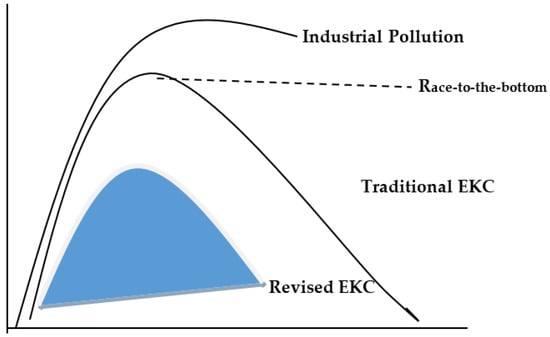 Figure 3. Different Scenarios of EKC Hypotheses. Source: Adapted from Taguchi [53].
Figure 3. Different Scenarios of EKC Hypotheses. Source: Adapted from Taguchi [53].
- (iv)
- Green Supply Chain Management Process (GSCMP): The discussion of the EKC hypothesis is carried forward under logistics operations, which are embodied with technological progress to make an intelligent machine design fuel-efficient and advanced for smart and green production. It is expected that with the moderation of technical factors with logistics performance indices would make a green supply chain process that would be less sensitive to carbon emissions. Thus, it would form different possibilities of the EKC hypothesis across countries.
2.1. Theoretical and Econometric Framework
The study used an endogenous growth model to analyze the country’s growth-specific factors in mitigating carbon emissions to substantiate the EKC hypothesis across countries. The endogenous growth model allows assessment of the importance of capital stock in economic production that ultimately causes pollution that negatively impacts the global environment. While on the other side, the revenue generated from the economic output at the later stages could be spent on decreasing carbon abatement costs. The environmental quality thus can be improved by stringent environmental reforms and abatement policies. These are the basis of the EKC relationship between income and pollution across countries. The study gets benefited from the earlier studies of Dinda [50,51], Stern [47,54], and Shahbaz et al. [55,56], to make four simultaneous equations for assessing EKC hypothesis of carbon dioxide damages under technological –induced logistics performance indices (TI-LPIs), economic growth, industry value-added, and high-tech industry:
where,
where, CDAM shows carbon emissions damage, LPI1 shows logistics quality services, LPI2 shows logistics quality in terms of transportation infrastructure and trade, GDPPC shows GDP per capita, IFS shows insurance and financial services, IND show industry value added, MHTECH shows medium and high-tech industry, PATENTS shows total patent applications, and TMARK shows total trade mark applications.
Equations (1)–(4a) shows that cost of carbon emissions is expected to be influenced by the greater use of logistics services, obsolete technologies, less insurance and financial coverage, industrialization, high-tech industry, and continued economic growth. These factors would further be analyzed under the EKC hypothesis domain through moderation of technology-induced LPIs to support the green supply chain management process (GSCMP).
The calculation of the turning point for the viability of EKC hypothesis remains a debatable issue, as Huang et al. [57], Lind and Mehlum [58], and many others emphasized the need to check the EKC hypothesis with some interval values, i.e., low and high interval values; hence EKC should fall between the two intervals. The study used different techniques to assess the viability of the EKC hypothesis under variables data and used ‘minimum value’ as the ‘lower interval value’ and ‘maximum value’ as the ‘higher interval’ value of the respective variables. The reason to use the range of the given variables is to check whether the inverted U-shaped EKC hypothesis falls between the given variables or not? It would give more analytical wisdom and be a more pragmatic approach to remain in the data points and check the existence of the EKC hypothesis across countries. Further, the study used a moderation effect between technological factors and LPIs with the relation of carbon damages and checked the ‘moderation turning point’ with some desirable additions. The formula to find the turning point is mentioned in Equations (3) and (4a), which is further discussed below:
Cost of Carbon Emissions = Maximum value of CDAM ÷ Moderation Turning Point
Prevention of Losses/Gains from CDAM = Cost of Carbon Emissions in US$ − Minimum Value of CDAM in US$)
Prevention of Losses/Gains from CDAM = Cost of Carbon Emissions in US$ − Minimum Value of CDAM in US$)
The given formula would help get information about the existence of EKC, estimation for calculation of the cost of carbon emissions that increase due to technology-induced LPIs, and losses/gains from CDAM across countries.
2.2. Research Methods
For obtaining the parameter estimates, the study utilized dynamic panel differenced GMM estimator in a group of 102 countries from 2010 through 2018. Figure 4 shows the research methods of the study.
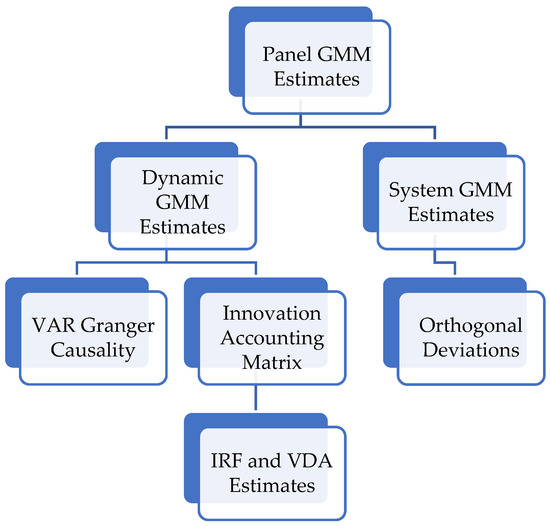
Figure 4.
Research Framework. Source: Author’s extraction.
The key benefits of using this estimator are as follows:
- (i)
- It works under large cross-sections and limited time. In this study, there are 102 countries in a panel setting with a period of the last nine years.
- (ii)
- It handles more than one endogenous issue in the given models. The current study used simultaneous equations modeling; thus the chances of any known endogenous issue may mislead the model. Therefore, for the results’ soundness, the differenced GMM estimator is good enough to observe this issue by including lagged instrumental variables.
- (iii)
- The problem of autocorrelation in panel settings might get affected by the studied parameter estimates. Thus, AR(1) and AR(2) would perform diagnostic tests to check any possible autocorrelation issues. If AR(1) does not fall in the 5% confidence interval, while AR(2) appears at a 5% significance level, the problem of autocorrelation problem would be resolved.
- (iv)
- The differenced GMM estimator is based upon the two-step procedure. In the first step, the regression is performed at differenced level, while in the second step, the lagged dependent variable included as a regressor in the given equations to remove simultaneity issues, and
- (v)
- The J-statistic and instrumental rank would be assessed to check the reliability of using given instruments as a true estimator in the given equations.
Bulajic et al. [59] and Borowski [60] rightly defining the research hypotheses in different economic settings. The study benefited from this and from using VAR Granger causality to check the following possible assumptions:
- -
- Whether LPIs (and technological factors, and growth-specific factors) Granger cause carbon damages, and simultaneously whether carbon damages Granger cause LPIs (and technical factors, and growth-specific factors)? If both conditions hold, then the given relationship would be bidirectional in nature.
- -
- Whether LPIs (and technological factors, and growth-specific factors) Granger cause carbon damages? The reverse does not hold the causal relationship, thus the given link would be unidirectional in nature.
- -
- Whether carbon damages Granger cause LPIs (and technological factors and growth-specific factors)? If the reverse does not hold the same then the given relationship would be one-directional in nature.
- -
- Whether LPIs (and technological factors, and growth-specific factors) do not Granger cause carbon damages, and simultaneously whether carbon damages do not Granger cause LPIs (and technical factors, and growth-specific factors)? In this case there will be no causal relationship between the stated variables.
Finally, the study used impulse response function (IRF) and variance decomposition analysis (VDA) to perform the following tasks:
- (i)
- To evaluate the relationship between the stated variables in inter-temporal settings.
- (ii)
- To assess the magnitude and direction between the variables over a time horizon.
- (iii)
- To check one standard error shock on the exogenous variables over the endogenous variable.
- (iv)
- These techniques would be desirable to get robust parameter estimates, which would further help devise policy implications.
3. Results
Table 3 shows the descriptive statistics of the variables. The cost of carbon emissions reaches its maximum value of 385,000,000,000, while at the same time LPIs shows good quality services both in terms of improving trade infrastructure and transportation facilities with an index value of 4.32 (LPI1) and 4.43 (LPI2) respectively. The country’s GDP per capita, on average, shows US$16,522.31 with a maximum value of US$92,077.57 and a minimum value of US$341.55. The average value of IFS, IND, and MHTECH is about 5.485% of commercial services exports, 27.520% of GDP, and 27.520% of manufacturing value-added. The patent applications included resident and non-resident applications, which were combined to obtain data of total patent applications across countries. Trademark applications are also used with the patent application data set to capture the technological evidence in a panel of selected countries. The minimum values of patent applications and trademark applications are 3 and 517, the maximum values are 1,542,002 and 2104411, and the average values are 24,479.16 and 45,722.60, respectively.

Table 3.
Descriptive Statistics.
Table 4 shows the correlation matrix and found that logistics indices (i.e., LPI1 and LPI2), GDP per capita, industry value-added, medium and high-tech manufacturing, and technological factors (i.e., PATENTS and TMARK) have a positive correlation with carbon damages with a correlation coefficient values of 0.226 (99% CI), 0.245 (99% CI), 0.057 (90% CI), 0.112 (99% CI), 0.206 (99% CI), 0.941 (99% CI), and 0.948 (99% CI), respectively. The result implies that logistics performance indices, technological factors, and growth–specific factors are the potential contributors to increasing carbon damages across countries. The logistics performance indices are positively influenced by the country’s economic growth, insurance and financial services, medium and high –tech industry, and technological factors. The country’s economic growth increases along with an increase in insurance and financial services, technical factors, and medium and high –tech industry. Insurance and financial services improved by technical factors, whereas an increase in medium and high -tech industry depends on technological advancement across countries. The correlation results confined their findings in three main aspects:

Table 4.
Correlation Matrix.
- (i)
- Logistics activities, technical factors, and growth-specific factors are considered the chief source to increase carbon damages across countries.
- (ii)
- The performance of logistics activities depends upon the country’s financial ability and technological capabilities.
- (iii)
- Country’s economic growth depends upon advancement in the technical factors and insurance and financial services in a panel of selected countries.
The overall assessment of the correlation matrix gives new insights into the possible relationship between the stated variables. Thus there is a high need to analyze the functional relationship between the explained and explanatory variables to devise the green supply chain management process.
Table 5 shows the dynamic panel GMM estimates and found that logistics performance indices positively correlate with carbon emissions damages in Equations (1) and (2) estimates, which tend to increase carbon damages due to higher logistics activities across countries. The earlier studies largely supported this argument from different perspectives, i.e., Khan et al. [27] concluded that logistics activities have a detrimental effect on air quality in the form of massive carbon emissions released due to lacking fuel-efficient technologies used in the logistics operation. The study emphasized the need to use renewable fuels to perform logistics operations to achieve green supply chain agendas across countries. Kannan et al. [61] argued that environmental consideration in the logistics business is mainly inflamed with negative environmental externalities, among which carbon emissions are the primary factor linked with logistics operations. The need to redesign the reverse logistics network is imperative to minimize ecological concerns during global transportation decisions. Herold and Lee [62] discussed the importance of green logistics in carbon management practices. They argued that the logistics and transportation sectors keenly observed and implemented low carbon emissions policies; however, carbon reporting in inventory management largely ignored the opportunity to work for the green supply chain management process. Yang et al. [63] assessed city level logistics performance of carbon emissions. They found that the return is varied at the city level, as some cities are embodied with technological frontiers that are helpful to decrease substantial carbon emissions, thus the advancement in cleaner production and shipment is desirable to reduce negative environmental externalities across countries.

Table 5.
Dynamic Panel GMM Estimates.
The results further show that medium and high-tech industry and technological factors are affiliated mainly with increased carbon damage in the form of high carbon abatement cost. Simultaneously, adequate insurance coverage and green financing services reduce the intensity of carbon emissions damage across countries. The results, although not supported by the inverted U-shaped EKC hypothesis in the relation of the country’s economic growth and carbon damages, however, tend to show a U-shaped relationship between them. The result implies that at the initial level, when the country’s income is just at US$341.54, the intensity of carbon damages was at a maximum of US$385,000,000,000, however, after reaching US$25,696.30, the cost of carbon emissions decreases at US$1,50,00,000. However, at later stages, when the country’s income grew more and reached its highest level, i.e., US$92,077.57, the cost of carbon emissions reached again at its maximum level. The complete description can be found in Figure 5.
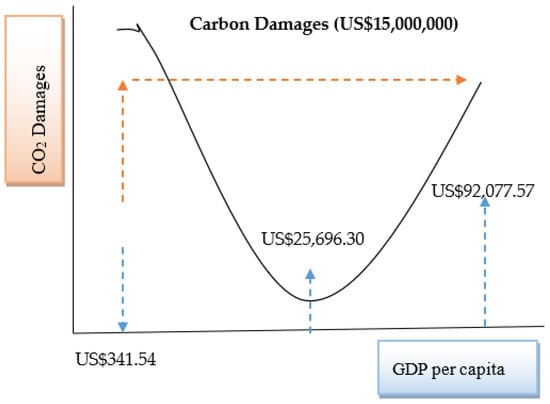
Figure 5.
U-shaped Curve between Carbon Damages and Economic Growth.
The moderation effect is included in Equations (3) and (4a). The technological factors, including patents application and trademark applications, are induced with logistics indices to assess green supply chain management practices and found a U-shaped relationship between carbon damages and moderation of technological factors. The result implies that carbon damages peak at US$385,000,000,000 while patent applications are lowest at 3 in number; however, when technology-induced LPI1 was included in carbon modeling, the technology-induced LPI1 reaching 27,600 applications, it turns to decrease carbon damages up to US$13,800,000. Further, when patent application reached its maximum level, i.e., 1,542,002 in number, carbon damages reached its maximum. Similarly, when the moderation effect of patents application induced with LPI2, it mainly decreases carbon damages up to US$6,100,000 at a threshold level of 63,100 patent applications. The complete description can be seen in Figure 6 and Figure 7.
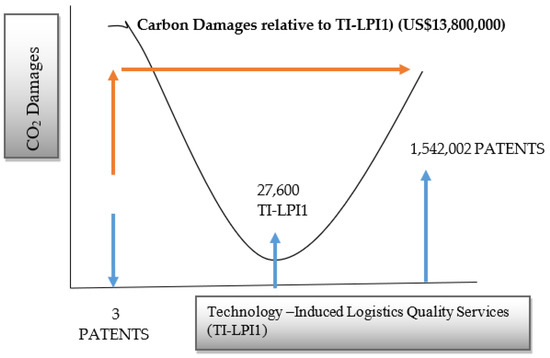
Figure 6.
Moderation U-shaped Curve between Carbon Damages and Technology Induced Logistics Performance Indices (LPI1 × PATENTS).
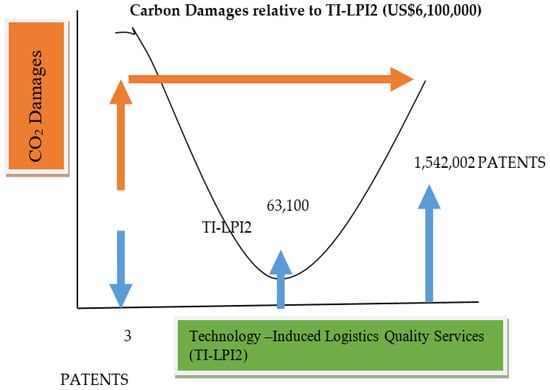
Figure 7.
Moderation U-shaped Curve between Carbon Damages and Technology Induced Logistics Performance Indices (LPI2 × PATENTS).
Finally, the trademark applications are induced with LPIs and found that carbon damages first decrease along with an increase in technology-induced LPIs; however, at later stages, it escalates carbon damages beyond the threshold level. The given U-shaped relationship with trademark applications- LPI1and carbon damages show that cost of carbon emissions increases at the lowest trademark applications of 517 in numbers while reaching threshold point, i.e., 11,300 applications, carbon damages decreases up to US$34,100,000 for LPI1 and US$20,200,000 for LPI2. Although there is a decline in carbon damages by adopting patent applications and trademark applications, however, the share of decreasing carbon damages is larger in trademark applications than patent applications. The complete description can be seen in Figure 8 and Figure 9.
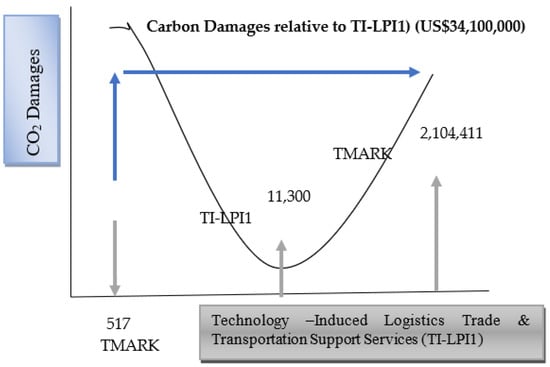
Figure 8.
Moderation U-shaped Curve between Carbon Damages and Technology Induced Logistics Performance Indices (LPI1 × TMARK).
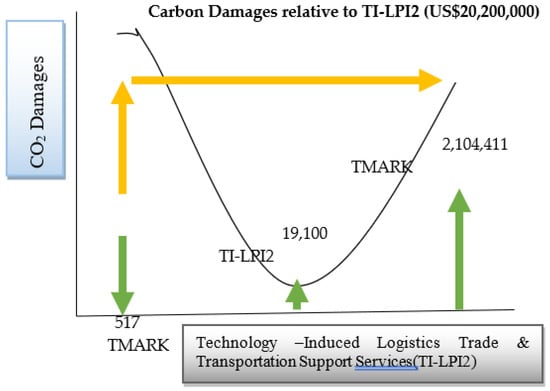
Figure 9.
Moderation U-shaped Curve between Carbon Damages and Technology Induced Logistics Performance Indices (LPI2 × TMARK).
Table 6 shows the fair calculation of carbon emissions’ cost due to the country’s economic growth and the moderation effect of technology with LPIs across countries. The results show that carbon damages largely decrease by trademark-induced LPI1, i.e., US$34,100,000, followed by trademark-induced LPI2, i.e., US$ 20,200,000, patents-induced LPI1, i.e., 13,800,000, GDP per capita, i.e., US$15,000,000, and patents –induced LPI2, i.e., US$61,00,000. The point of interest is that technology-induced LPI1 has a greater magnitude in terms of decreasing the cost of carbon emissions across countries.

Table 6.
Calculation of Carbon Damages with Technological –Induced Logistics Performance Indices.
During the calculation of losses/gains of carbon damages from GDP per capita, LPI1 × TMAR, and LPI2 × TMAR, it is evident that carbon damages decrease by US$15,000,000, US$34,100,000, and US$20,200,000 which prevents to gain of almost 5.7%, 141.1%, and 42.8% respectively, from the lowest increase in carbon damages. In case of moderation effect of patents with LPI1 and LPI2, it is evident that carbon damages decrease from US$13,800,000 and US$6,100,000 that have a share of −2.4% and −56.9% relative to the minimum value of carbon damages, which reduces the cost of carbon emissions about US$−343239 and US$−8,043,239 respectively. Table 7 shows the estimates of VAR Granger causality, IRF, and VDA.

Table 7.
VAR Granger Causality, impulse response function (IRF), and variance decomposition analysis (VDA) Estimates.
The causality estimates show that carbon damages and GDP per capita both have a bidirectional relationship with patents applications, whereas, GDP per capita has a unidirectional casualty from carbon damages and logistics indices. The result supported the growth-led carbon damages and growth -led logistics performance across countries. The other estimates show a unidirectional causality running from industry value added to GDP per capita, LPI1, and IFS; patents to carbon damages and GDP per capita; medium and high tech industry to LPIs and PATENTS; and CDAM to TMARK. The results supported that industry-led growth, industry-led LPIs, technology-led carbon damages, and high-tech industry led to technical indicators across countries. The IRF estimates suggested that, except for industry value-added, technological factors, medium and high-tech industry, and growth-specific factors are likely to increase carbon damages for the next ten-year time period, whereas, industry value-added will likely minimize carbon damages due to imposition of strong environmental regulations across countries. The VDA estimates suggested that technological factors, i.e., patents and trademark applications, would exert a greater magnitude of 28.129% and 15.539% to influenced carbon damages. At the same time, there is a likelihood that industry value-added will have little effect on carbon damages over a time horizon.
4. Conclusions
The study proposed a smart design for the green supply chain management process aligned with logistics activities and technological factors in moving forward for intelligent and green production. The fuel-efficient technologies are desirable in logistics operations that could lead to a way forward for green development. The study investigated the real cost of carbon emissions influenced by technological factors, logistics activities, and growth-specific factors by using a large sample of countries from 2010 through 2018. The differenced panel GMM estimates show the U-shaped relationship between (i) GDP per capita and carbon damages, and (ii) moderation of technological factors with LPIs and carbon damages. The causality estimates confirmed the technology-led growth, growth-led logistics indices, and technology-led carbon damages across countries. The forecast relationship shows that technological factors, logistics performance indices, and growth specific factors would likely increase carbon damages, while technical factors have a more significant share in influencing carbon damages over a time horizon. The overall results come to the following policy implications:
- Advancement in cleaner production technologies is imperative to reduce the cost of carbon emissions across countries.
- Fuel efficient technologies can be used in logistics operations to improve quality services.
- Logistics operations should be diversified and compliant with all environmental regulations, including ISO-based environmental certifications, ISO certifications for efficient manufacturing units processing, ISO standardization certifications, and ISO certification for clean vehicle transportations.
- Insurance and financial services could expand business opportunities and manufacturers’ payoff by transporting their shipments from one place to another place, while the theft and other damages could be covered by efficient insurance services. Financial services’ soundness would also create a strong liaison between the financial market and investors to decide on smart production. Hence the process of green supply chain management would be enhanced with technical expertise.
- The cost of carbon emissions is further reduced by sustainable production decisions and high-tech productions, which is a way forward for smart production systems.
These policies enlightened the way towards green supply chain management that is mainly dependent upon resourceful logistics activities, cleaner technologies, sound financial markets, efficient insurance coverage, and quick production processes. All these factors would primarily be needed to go-for-green policies on a global scale.
Author Contributions
Conceptualization, M.K.A., M.A.K., and U.A.; methodology, R.B., K.Z., and M.I.; software, K.Z., Y.I., and A.K.; validation, M.K.A., S., and A.K.; formal analysis, M.K.A., Z.A.B., and K.Z.; investigation, M.A.K., R.B., U.A., and M.I.; resources, U.A.; data curation, Z.A.B., U.A.; writing—original draft preparation, M.K.A., and M.A.K.; Writing—review and editing, M.A.K., S., Y.I., A.K., and M.I.; visualization, M.I.; supervision, M.K.A. All authors have read and agreed to the published version of the manuscript.
Funding
This research received no external funding.
Conflicts of Interest
The authors declare no conflict of interest.
Appendix A

Table A1.
List of Sample Countries.
Table A1.
List of Sample Countries.
| “Albania, Algeria, Argentina, Armenia, Australia, Austria, Azerbaijan, Bahrain, Bangladesh, Belarus, Belgium, Bolivia, Bosnia and Herzegovina, Botswana, Brazil, Bulgaria, Cambodia, Canada, Chile, China, Colombia, Costa Rica, Croatia, Cyprus, Czech Republic, Ecuador, Egypt, El Salvador, Estonia, Ethiopia, Finland, France, Georgia, Germany, Greece, Guatemala, Haiti, Honduras, Hong Kong, Hungary, Iceland, India, Indonesia, Italy, Jamaica, Japan, Jordan, Kazakhstan, Kenya, Korea, Kyrgyz Republic, Lao PDR, Latvia, Lebanon, Lithuania, Madagascar, Malaysia, Malta, Mauritius, Mexico, Moldova, Mongolia, Montenegro, Morocco, Mozambique, Namibia, Nepal, Nigeria, North Macedonia, Norway, Oman, Pakistan, Panama, Peru, Philippines, Poland, Portugal, Qatar, Romania, Russia, Rwanda, Saudi Arabia, Serbia, Singapore, Slovak Republic, Slovenia, South Africa, Spain, Sri Lanka, Sweden, Switzerland, Thailand, Trinidad and Tobago, Tunisia, Turkey, Ukraine, United Kingdom, United States, Uruguay, Venezuela RB, Zambia”. |
References
- United Nation. Sustainable Development Goals. 2015. Available online: https://sustainabledevelopment.un.org/?menu=1300 (accessed on 21 April 2020).
- Zand, F.; Yaghoubi, S.; Sadjadi, S.J. Impacts of government direct limitation on pricing, greening activities and recycling management in an online to offline closed loop supply chain. J. Clean. Prod. 2019, 215, 1327–1340. [Google Scholar] [CrossRef]
- Van Wassenhove, L.N. Sustainable innovation: Pushing the boundaries of traditional operations management. Prod. Oper. Manag. 2019, 28, 2930–2945. [Google Scholar] [CrossRef]
- Marsden, T.; Rucinska, K. After COP21: Contested transformations in the energy/agri-food nexus. Sustainability 2019, 11, 1695. [Google Scholar] [CrossRef]
- Evans, S.; Gabbatis, J. COP25: Key Outcomes Agreed at the UN Climate Talks in Madrid, 2019. COP25 Madrid, 15th December 2019. Available online: https://www.carbonbrief.org/cop25-key-outcomes-agreed-at-the-un-climate-talks-in-madrid (accessed on 2 August 2020).
- World Bank. Aggregated LPI 2012–2018. 2019. Available online: https://lpi.worldbank.org/international/aggregated-ranking (accessed on 21 April 2020).
- WIPO. WIPO IP Facts and Figures 2018; World Intellectual Property Organization: Geneva, Switzerland, 2018. [Google Scholar]
- Avgerou, C. The link between ICT and economic growth in the discourse of development. In Organizational Information Systems in the Context of Globalization; Springer: Boston, MA, USA, 2003; pp. 373–386. [Google Scholar]
- Jungmittag, A. Innovations, technological specialisation and economic growth in the EU. Int. J. Econ. Policy 2004, 1, 247–273. [Google Scholar] [CrossRef]
- Mokyr, J. Long-term economic growth and the history of technology. In Handbook of Economic Growth; Elsevier: Amsterdam, The Netherlands, 2005; Volume 1, pp. 1113–1180. [Google Scholar]
- Smith, S.; Newhouse, J.P.; Freeland, M.S. Income, insurance, and technology: Why does health spending outpace economic growth? Health Aff. 2009, 28, 1276–1284. [Google Scholar] [CrossRef] [PubMed]
- Prieto, L. Innovation and Economic Growth: Cross-Country Analysis using Science and Technology Indicators. Ph.D. Thesis, Georgetown University, Washington, DC, USA, April 2017. [Google Scholar]
- Khan, H.U.R.; Zaman, K.; Khan, A.; Islam, T. Quadrilateral relationship between information and communications technology, patent applications, research and development expenditures, and growth factors: Evidence from the group of seven (G-7) countries. Soc. Indic. Res. 2017, 133, 1165–1191. [Google Scholar] [CrossRef]
- Irandoust, M. The renewable energy-growth nexus with carbon emissions and technological innovation: Evidence from the Nordic countries. Ecol. Indic. 2016, 69, 118–125. [Google Scholar] [CrossRef]
- Wang, M.; Feng, C. Decoupling economic growth from carbon dioxide emissions in China’s metal industrial sectors: A technological and efficiency perspective. Sci. Total Environ. 2019, 691, 1173–1181. [Google Scholar] [CrossRef]
- Demartini, M.; Pinna, C.; Aliakbarian, B.; Tonelli, F.; Terzi, S. Soft drink supply chain sustainability: A case based approach to identify and explain best practices and key performance indicators. Sustainability 2018, 10, 3540. [Google Scholar] [CrossRef]
- Mastos, T.D.; Nizamis, A.; Vafeiadis, T.; Alexopoulos, N.; Ntinas, C.; Gkortzis, D.; Papadopoulos, A.; Ioannidis, D.; Tzovaras, D. Industry 4.0 sustainable supply chains: An application of an IoT enabled scrap metal management solution. J. Clean. Prod. 2020, 269, 122377. [Google Scholar] [CrossRef]
- Kolhe, M.L.; Labhasetwar, P.K.; Suryawanshi, H.M. Smart Technologies for Energy, Environment and Sustainable Development: Select Proceedings of ICSTEESD 2018; Springer: Berlin, Germany, 2019. [Google Scholar]
- Dyczkowska, J.; Reshetnikova, O. New Technological Solutions in Logistics on the Example of Logistics Operators in Poland and Ukraine. In SMART Supply Network; Springer: Cham, Switzerland, 2019; pp. 47–69. [Google Scholar]
- Wang, Y.; Ren, H.; Dong, L.; Park, H.S.; Zhang, Y.; Xu, Y. Smart solutions shape for sustainable low-carbon future: A review on smart cities and industrial parks in China. Technol. Forecast. Soc. Chang. 2019, 144, 103–117. [Google Scholar] [CrossRef]
- Zaman, K.; Shamsuddin, S. Green logistics and national scale economic indicators: Evidence from a panel of selected European countries. J. Clean. Prod. 2017, 143, 51–63. [Google Scholar] [CrossRef]
- Khan, S.A.R.; Qianli, D. Does national scale economic and environmental indicators spur logistics performance? Evidence from UK. Environ. Sci. Pollut. Res. 2017, 24, 26692–26705. [Google Scholar] [CrossRef]
- Zaman, K. The impact of hydro-biofuel-wind energy consumption on environmental cost of doing business in a panel of BRICS countries: Evidence from three-stage least squares estimator. Environ. Sci. Pollut. Res. 2018, 25, 4479–4490. [Google Scholar] [CrossRef] [PubMed]
- Yu, Z.; Golpîra, H.; Khan, S.A.R. The relationship between green supply chain performance, energy demand, economic growth and environmental sustainability: An empirical evidence from developed countries. LogForum 2018, 14, 479–494. [Google Scholar] [CrossRef]
- Aldakhil, A.M.; Nassani, A.A.; Awan, U.; Abro, M.M.Q.; Zaman, K. Determinants of green logistics in BRICS countries: An integrated supply chain model for green business. J. Clean. Prod. 2018, 195, 861–868. [Google Scholar] [CrossRef]
- Liu, J.; Yuan, C.; Hafeez, M.; Yuan, Q. The relationship between environment and logistics performance: Evidence from Asian countries. J. Clean. Prod. 2018, 204, 282–291. [Google Scholar] [CrossRef]
- Khan, S.A.R.; Jian, C.; Zhang, Y.; Golpîra, H.; Kumar, A.; Sharif, A. Environmental, social and economic growth indicators spur logistics performance: From the perspective of South Asian Association for Regional Cooperation countries. J. Clean. Prod. 2019, 214, 1011–1023. [Google Scholar] [CrossRef]
- Liang, Z.; Chiu, Y.H.; Li, X.; Guo, Q.; Yun, Y. Study on the Effect of Environmental Regulation on the Green Total Factor Productivity of Logistics Industry from the Perspective of Low Carbon. Sustainability 2020, 12, 175. [Google Scholar] [CrossRef]
- Lan, S.; Tseng, M.L.; Yang, C.; Huisingh, D. Trends in sustainable logistics in major cities in China. Sci. Total Environ. 2020, 712, 136381. [Google Scholar] [CrossRef]
- Kumail, T.; Ali, W.; Sadiq, F.; Wu, D.; Aburumman, A. Dynamic linkages between tourism, technology and CO2 emissions in Pakistan. Anatolia 2020, 1–13. [Google Scholar] [CrossRef]
- Ahmad, M.; Khattak, S.I.; Khan, A.; Rahman, Z.U. Innovation, foreign direct investment (FDI), and the energy–pollution–growth nexus in OECD region: A simultaneous equation modeling approach. Environ. Ecol. Stat. 2020, 27, 203–232. [Google Scholar] [CrossRef]
- Ghazvini, M.; DehghaniMadvar, M.; Ahmadi, M.H.; Rezaei, M.H.; El Haj Assad, M.; Nabipour, N.; Kumar, R. Technological assessment and modeling of energy-related CO2 emissions for the G8 countries by using hybrid IWO algorithm based on SVM. Energy Sci. Eng. 2020, 8, 1285–1308. [Google Scholar] [CrossRef]
- Shahbaz, M.; Raghutla, C.; Song, M.; Zameer, H.; Jiao, Z. Public-private partnerships investment in energy as new determinant of CO2 emissions: The role of technological innovations in China. Energy Econ. 2020, 86, 104664. [Google Scholar] [CrossRef]
- Usman, O.; Olanipekun, I.O.; Iorember, P.T.; Abu-Goodman, M. Modelling environmental degradation in South Africa: The effects of energy consumption, democracy, and globalization using innovation accounting tests. Environ. Sci. Pollut. Res. 2020, 27, 8334–8349. [Google Scholar] [CrossRef]
- Khan, Z.; Hussain, M.; Shahbaz, M.; Yang, S.; Jiao, Z. Natural resource abundance, technological innovation, and human capital nexus with financial development: A case study of China. Resour. Policy 2020, 65, 101585. [Google Scholar] [CrossRef]
- Saleem, H.; Khan, M.B.; Shabbir, M.S. The role of financial development, energy demand, and technological change in environmental sustainability agenda: Evidence from selected Asian countries. Environ. Sci. Pollut. Res. 2020, 27, 5266–5280. [Google Scholar] [CrossRef]
- Azimi, M.; Feng, F.; Zhou, C. Environmental policy innovation in China and examining its dynamic relations with air pollution and economic growth using SEM panel data. Environ. Sci. Pollut. Res. 2020, 27, 9987–9998. [Google Scholar] [CrossRef]
- Ibrahiem, D.M. Do technological innovations and financial development improve environmental quality in Egypt? Environ. Sci. Pollut. Res. 2020, 27, 10869–10881. [Google Scholar] [CrossRef]
- Mariano, E.B.; Gobbo, J.A.; De Castro Camioto, F.; Do Nascimento Rebelatto, D.A. CO2 emissions and logistics performance: A composite index proposal. J. Clean. Prod. 2017, 163, 166–178. [Google Scholar] [CrossRef]
- Lu, M.; Xie, R.; Chen, P.; Zou, Y.; Tang, J. Green transportation and logistics performance: An improved composite index. Sustainability 2019, 11, 2976. [Google Scholar] [CrossRef]
- Naz, S.; Sultan, R.; Zaman, K.; Aldakhil, A.M.; Nassani, A.A.; Abro, M.M.Q. Moderating and mediating role of renewable energy consumption, FDI inflows, and economic growth on carbon dioxide emissions: Evidence from robust least square estimator. Environ. Sci. Pollut. Res. 2019, 26, 2806–2819. [Google Scholar] [CrossRef] [PubMed]
- Anser, M.K.; Yousaf, Z.; Awan, U.; Nassani, A.A.; Qazi Abro, M.M.; Zaman, K. Identifying the Carbon Emissions Damage to International Tourism: Turn a Blind Eye. Sustainability 2020, 12, 1937. [Google Scholar] [CrossRef]
- Sarkodie, S.A.; Strezov, V. A review on environmental Kuznets curve hypothesis using bibliometric and meta-analysis. Sci. Total Environ. 2019, 649, 128–145. [Google Scholar] [CrossRef]
- Taghizadeh-Hesary, F.; Yoshino, N. Sustainable Solutions for Green Financing and Investment in Renewable Energy Projects. Energies 2020, 13, 788. [Google Scholar] [CrossRef]
- Li, L.; Hong, X.; Peng, K. A spatial panel analysis of carbon emissions, economic growth and high-technology industry in China. Struc. Chang. Econ Dyn. 2019, 49, 83–92. [Google Scholar] [CrossRef]
- World Bank. World Development Indicator; World Bank: Washington, DC, USA, 2019. [Google Scholar]
- Stern, D.I. The rise and fall of the environmental Kuznets curve. World. Dev. 2004, 32, 1419–1439. [Google Scholar] [CrossRef]
- Galeotti, M.; Lanza, A.; Pauli, F. Reassessing the environmental Kuznets curve for CO2 emissions: A robustness exercise. Ecol. Econ. 2006, 57, 152–163. [Google Scholar] [CrossRef]
- Martínez-Zarzoso, I.; Bengochea-Morancho, A. Pooled mean group estimation of an environmental Kuznets curve for CO2. Econ. Lett. 2004, 82, 121–126. [Google Scholar] [CrossRef]
- Dinda, S. Environmental Kuznets curve hypothesis: A survey. Ecol. Econ. 2004, 49, 431–455. [Google Scholar] [CrossRef]
- Dinda, S. A theoretical basis for the environmental Kuznets curve. Ecol. Econ. 2005, 53, 403–413. [Google Scholar] [CrossRef]
- Grossman, G.M.; Krueger, A.B. Environmental Impacts of a North American Free Trade Agreement; No. Working Papers 3914; National Bureau of Economic Research: Cambridge, MA, USA, 1991. [Google Scholar]
- Taguchi, H. The environmental Kuznets curve in Asia: The case of sulphur and carbon emissions. Asia-Pac. Dev. J. 2013, 19, 77–92. [Google Scholar] [CrossRef]
- Stern, D.I. The environmental Kuznets curve after 25 years. J. Bioecon. 2017, 19, 7–28. [Google Scholar] [CrossRef]
- Shahbaz, M.; Solarin, S.A.; Ozturk, I. Environmental Kuznets curve hypothesis and the role of globalization in selected African countries. Ecol. Indic. 2016, 67, 623–636. [Google Scholar] [CrossRef]
- Shahbaz, M.; Mahalik, M.K.; Shahzad, S.J.H.; Hammoudeh, S. Testing the globalization-driven carbon emissions hypothesis: International evidence. Int. Econ. 2019, 158, 25–38. [Google Scholar] [CrossRef]
- Huang, H.C.; Lin, Y.C.; Yeh, C.C. An appropriate test of the Kuznets hypothesis. Appl. Econ. Lett. 2012, 19, 47–51. [Google Scholar] [CrossRef]
- Lind, J.T.; Mehlum, H. With or without U? The appropriate test for a U-shaped relationship. Oxf. Bull. Econ. Stat. 2010, 72, 109–118. [Google Scholar] [CrossRef]
- Bulajic, A.; Stamatovic, M.; Cvetanovic, S. The importance of defining the hypothesis in scientific research. Int. J. Educ. Adm. Policy Stud. 2012, 4, 170–176. [Google Scholar] [CrossRef]
- Borowski, P. Adaptation Strategies in Energy Sector Enterprises. 2020. Available online: https://www.researchsquare.com/article/rs-27944/v1 (accessed on 2 August 2020).
- Kannan, D.; Diabat, A.; Alrefaei, M.; Govindan, K.; Yong, G. A carbon footprint based reverse logistics network design model. Resour. Conserv. Recycl. 2012, 67, 75–79. [Google Scholar] [CrossRef]
- Herold, D.M.; Lee, K.H. Carbon management in the logistics and transportation sector: An overview and new research directions. Carbon Manag. 2017, 8, 79–97. [Google Scholar] [CrossRef]
- Yang, J.; Tang, L.; Mi, Z.; Liu, S.; Li, L.; Zheng, J. Carbon emissions performance in logistics at the city level. J. Clean. Prod. 2019, 231, 1258–1266. [Google Scholar] [CrossRef]
© 2020 by the authors. Licensee MDPI, Basel, Switzerland. This article is an open access article distributed under the terms and conditions of the Creative Commons Attribution (CC BY) license (http://creativecommons.org/licenses/by/4.0/).